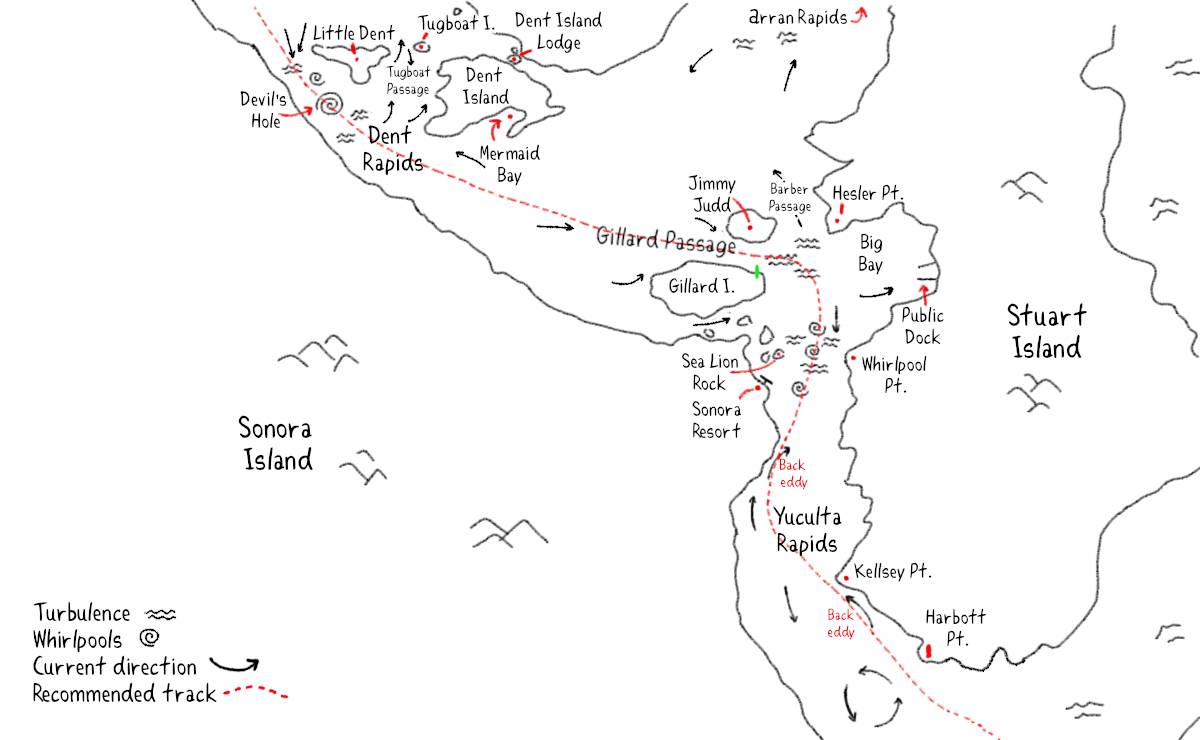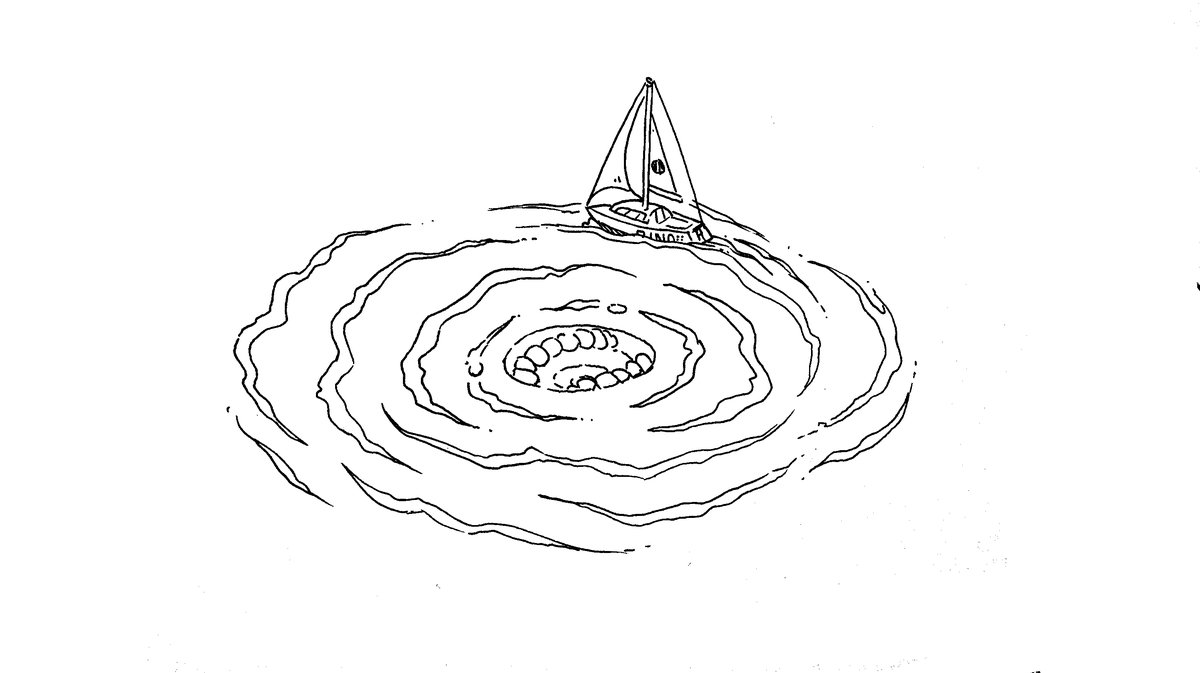yuculta and dent rapids

What we refer to on this page as the Yuculta and Dent rapids are on the traditional, stolen, unceded land of the We Wai Kum, Kwiakah and Homalco First Nations people; the Liǧʷiłdax̌ʷ Treaty Society and the We Wai Kai Nation.
- Yucultas to Gillard Passage: 2.1 NM
- Gillard Passage: 0.3 NM
- Gillard Passage to Dent: 2.2 NM
Max flood: 12.5 kn
Max ebb: 9.5 kn
The series of passes from the Yucultas(Yucultas, Gillard Passage and Dent, pronounced uke-la-taws), spans close to 5 NM. For reference, most rapids on this coast are under 0.5 NM. The difficulty in traversing these rapids is because of the distance that must be covered in a short period of time, and that each turn at different times (on an ebb, Dent turns before Gillard). These rapids run fast at peak flood, or ebb. Remember that in this area, the ebb flows north, and the flood flows south.
For both the Yucultas and Dent, the reference station for current in the CHS Tables and/or in Ports and Passes is Gillard Passage. Dent turns to flood 15 minutes and to ebb 25 minutes before Gillard. During big tidal exchanges, whirlpools, overfalls and boils can appear and endanger passing boats. Yuculta Rapids turn to flood 25 minutes, and to ebb 5 minutes after Gillard.

The most notorious obstacle marked up as Devil's Hole on nautical charts, a good name for a fearsome whirlpool that forms just south of Dent on a growing flood. Devil's Hole doesn't form on the ebb, because of how the water is deflected as it travels, but it doesn't make the transit safe at anything but slack(if the traveling is not happening on a neap tide). After slack water, the current rises to maximum speed rapidly, leaving little time to pass each rapid.
Northbound Tactics
On May 12th at 0500, we left Frances Bay for the Yuculta and Dent rapids, with plans to traverse all 3 in one go. If the goal is to get there in a timely way with a slow boat, one must find an anchorage that is near the rapids... but there aren't many choices. The closest anchorage is Florence Cove in Hole in the Wall, but it can get quite gusty in there, wind depending, we chose to anchor in Frances Bay, not because we thought it was ideal, but because it was the second closest that offered a bit more protection.
Because Pino doesn't motor fast, we like to cross dangerous rapids on neap tides, when the tidal exchange isn't as large, which reduces the strength of the current. Rapids on neap tides aren't nearly as violent, and are much safer to transit. We passed all 3 in one day following the advice listed below.
Ports and Passes tactic: When northbound, arrive at Yuculta Rapids 30 minutes before slack at Gillard Passage. You will have to stem the last of the flood in Yuculta Rapids(and maybe even Gillard Passage), but you should arrive at Dent Rapids when it is nearly slack. The beginning of the ebb will carry you through.
Notes. Not sure what kind of speed Ports and Passes assumes a boat can do, but 30 minutes seems short. It it possible this advice is geared at motored vessels.
Canadian Yachting tactic (By William Kelly): When northbound, slower vessels arriving at the end of a flood can take advantage of a back eddy along the Stuart Island shore up to Kellsey Pt. From there, if conditions are safe, cross to the Sonora Island side of the channel (where the north-going ebb current begins early) and continue to Gillard Passage. We usually like to be in Gillard Pass at the onset of the ebb, but if you find yourself battling a lot of flood current, an alternate route north is to proceed across the mouth of Big Bay and navigate east of the 15.8-metre sounding in Barber Passage, which runs slightly slower than Gillard Passage. Proceeding north from Jimmy Judd Island, arrive with Little Dent Island to starboard and the ebb under way. On a strong flood, Devil's Hole, a turbulent and aerated setion of water south of little Dent Island, can be a frightening spot, but on an ebb the stream is much more consistent because there is nothing to deflect the flowing water. If you find yourself riding a faster ebb than you have planned, stay in the middle of the pass to avoid the set to Tugboat Passage with its dangerous rocks. Once you are clear of Dent Rapids, that is, west of Little Dent, steer north of the shoal patch marked at 6.4 metres depth about a half-mile northwest of the QR light on Little Dent. There can be lots of turbulence here on an ebb.
Notes. We stuck to the regular passes for our transit, we didn't stray so we can't vouch for the Barber Passage detour, but it is wider so it's very likely a good alternate.
Dreamspeaker Series tactic: If you are heading N, approach the Yucultas off Kellsey Pt. on the Stuart Island shoreline an hour prior to the turn to the ebb, cross over, take advantage of the northerly current that prevails along the Sonora Island shore and transit Gillard Passage. It's approximately 5 NM from Kellsey Pt to the Turbulent-free waters in Cordero Channel N of little Dent Island. A sailboat at 6 knots should be able to transit Dent Rapids before the ebb has had time to build to full force.
Notes. Our boat doesn't motor at 6 knots, but we still managed to get good timing by arriving a bit less than 1 hour in advance.
Taking each rapid separately. A slow northbound boat that cannot, or doesn't want, to transit all 3 passes at once, say they cannot time the passing of these rapids with a neap tide, ought to aim for near slack at the Yucultas, transit through, and then spend the night at a dock in Big Bay. The community dock appears cheap and there is a lot of dock space. On the next ebb, near slack, transit Gillard Pass and head for Mermaid Bay to anchor to wait for an ebb slack at Dents before crossing (there is also the more expensive docks tucked just northeast of Dent Island, like Dent Island Resort, and Fisherman's Landing, but they charge something like 4$/foot for an overnight stay).
We had been dreading this passage for a while, but the constant gale warnings in Johnstone Strait forced our hand. We could bypass some of the bad weather by using the back channels, but of course this too comes with some level of danger. Both Johnstone Strait and the back channels are tricky, it is not surprising how some boats never go farther north than Desolation Sound. In all, with careful planning, transiting rapids isn't dangerous, but choosing this path means having to motor. We transited through the 3 rapids with zero issues. After making it past Dent, we made coffee and sipped it to warm our bodies, drinking coffee prior to making a possibly troublesome transit is always a bad idea, it makes us too jittery. Coffee after the difficult bit is over is our prize.
After the rapids, we went to dock at Shoal Bay.
Southbound Tactics
In early August 2024 we went through these same rapids again, but southbound. Tackling these rapids from north to south isn't as difficult, because on a flooding tide Dent Rapids turns to slack first (15 minutes before slack at Gillard Passage), and Yuculta Rapids turn to flood 25 minutes after slack at Gillard Passage. The main tactic is to arrive at Dents Rapids 15 minutes before slack at Gillard Passage, to catch it at its quietest, and to then proceed through both Gillard Passage and Yuculta Rapids at/or near slack.
Like in the northbound tactics, it is possible to stop between each leg in Mermaid Bay, or at the community docks in Big Bay. We tackled all 3 rapids at once because the tidal exchange wasn't too big and that we knew our boat could get through.
We left Bickley Bay at noon to arrive at Dents for 1517, we left early because we expected to have to fight some current to get there, but we did not feel any resistance in the water for two reasons: we had some wind to help us along (15-25 NW), and as already stated, the tidal exchange was not big. For a slow boat, having some wind really helps with progress. We had wind from Bickley Bay right up until Denham Islands in Cordero Channel. The wind came back after passing the Dent Rapids, which really helped push us towards Gillard Passage. The wind wasn't strong in this channel, but it added maybe 1/2 knot of speed-it isn't much, but it makes a very big difference for a boat, like ours, that performs better under sail.
The waters before the Dents were a bit disturbed, with a few boils, we were going towards it very slowly(2.5 kn at times, fighting the last of the current near Dents), but because we had left Bickley Bay extra early we were able to make it in time. When passing through the Dents the water was very smooth, same for both Gillard Passage and the Yucultas. The max ebb for Gillard prior to us passing was 3.6 kn, and the max flood was 4.8 kn. I cannot overstate this enough, on a very big tidal exchange, say the ebb was running at 9.5 kn and will turn to flood at 12.5 kn, the waters won't be as smooth, and the window for transiting will be much shorter.
Shoal Bay is a good place to wait before tackling the rapids, but it is very popular in the high summer. Other options include Bickley Bay - although if high NW winds are forecast for Johnstone Strait, make sure your anchor is set well because the gusts that swirl in there are very strong. There is also good anchoring in Tallac Bay and the Cordero Islands. The closer you anchor to Green Point Rapids the harder it will be for a slow boat to leave early to catch slack at Dents, because the current can be quite strong in that area on a big tide. There are other anchorages in Nodales Channel too, but you'll also have to buck a bit of current to get to the Dents(we haven't tried any anchorage there yet).